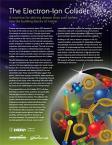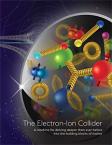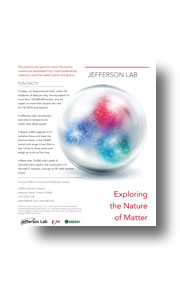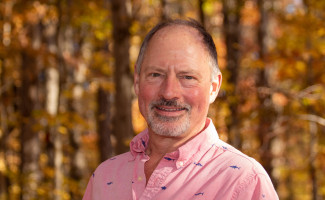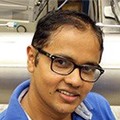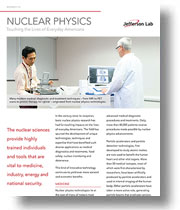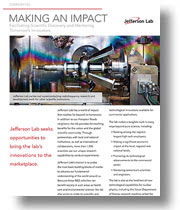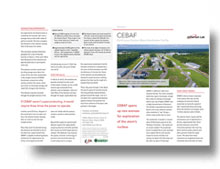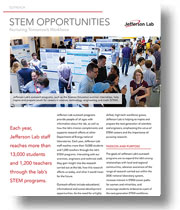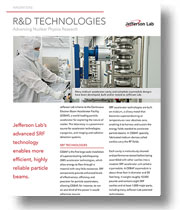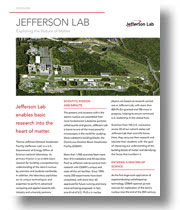Creativity and engineering make possible new art and cutting-edge nanotube technology
If you attended the famous Burning Man festival in 2018, you may have seen a giant, kinetic art installation co-built by Kevin Jordan, a Jefferson Lab electrical engineer. Jordan and George Neil, his former supervisor at the lab, have been traveling North America showcasing their namesake Double Helix Art installations, which feature a double helix light apparatus held high in the air.
Jordan and Neil’s mesmerizing work is a kinetic sculpture that is comprised of two parallel steel cables that are attached to a pair of steel pipes rigged up to 75 feet apart and suspended 32 feet in the air. Long poles are attached perpendicularly to the two steel cables in intervals resembling ribs. Those long poles stretch for several feet and at the end of each pole is a colorful lightbulb. When the artwork is still, it slightly resembles an elevated train track.
“Basically, this is a scaled-up version of a wave machine from a STEM educator in Malaysia,” explains Jordan. “Their jelly babies and kabob sticks are equivalent to our steel pipes and LEDs. The disturbance goes from one end of the machine to the other. Visitors can experiment by pulling on two ropes, which puts energy into the cables on one end of the machine and seeing how that energy propagates the waves all the way down the machine and reflects back.”
The wave “frequency” speeds or slows and changes the height of the wave crest in response to the way a visitor interacts with the ropes. However, the system does not have to be interactive and can run off of a motor instead of human power.
Jordan and Neil call their work and corresponding partnership “Double Helix Art.” In addition to Burning Man, they have thus far showcased it at the Toronto Distillery District, at the Olbrich Botanical Gardens in Madison, Wisconsin, and at the Virginia Living Museum and at Brooks Crossing in Newport News.
Through their art, Jordan and Neil have connected with other institutions to make public art possible. Read more about Jordan’s work to make an installation possible at Christopher Newport University.
Creativity also leads to scientific advancements
Jordan’s creativity extends far beyond his interest in kinetic art. He also applies creative approaches to his work at Jefferson Lab as lead for the Diagnostics Development group in the lab’s Center for Advanced Studies of Accelerators.
“We are responsible for improving the diagnostics for the CEBAF electron accelerator. We have been focusing on non-invasive instruments that can both serve as an early warning of a problem and to better resolve issues with a goal of reducing accelerator downtime,” he says.
He’s also working on a project to adapt commercial microwave transmitters for use at the lab. Currently, the lab uses specially designed klystrons to inject power into the components that accelerate the electron beams in CEBAF. Using commercially available transmitters instead can reduce the cost of building or upgrading particle accelerators in the future.
“I have also been coordinating the testing of new LCLS-II cryomodules at the LERF facility, supporting the Gun Test Stand, and have done the control system for bunched electron cooling of carbon ion beam at the Institute of Modern Physics in Lanzhou China,” he says.
Jordan rounds out his work duties with service-oriented tasks. He currently serves on the Machine Advisory Committee for the Canadian Light Source in Saskatoon, Canada, the Scientific Program Committee for the International Beam Instrument Conference, and is the chair of the Accelerator Division seminar committee.
And applied technologies, too
Jordan also has helped to invent a brand new, cutting-edge material that is stronger than Kevlar, electrically insulating, and thermally conductive. This new material, boron nitride nanotubes, is the focus of Jordan’s Jefferson Lab spin-off business: BNNT Materials.
“We make a volatile mix of super corrosive gasses and vapors, and when they condense out with the right conditions, they make these beautiful crystalline structures,” explains Jordan.
The structures can be treated as a fiber, similar to a cotton ball.
“We stretch it into long fibers and then spin those lengths of fibers together,” explains Jordan. “On a molecular level, the Van der Waals forces will hold the fibers together in an extremely strong bond.”
What exactly will the BNNT technology be used for outside of the lab?
“We are a solution looking for a problem,” says Jordan, who has his name on 39 total patents. “We can solve all kinds of problems.”
For instance, the material can be used in thermal applications to manage heat in computer chips and electric vehicles or even high-flying electric aircraft engines. It can enhance the mechanical properties of metals, ceramics and polymer composites. Another application for the technology is as a photocatalyst for water treatment facilities.
“Perfluorooctanoic acid (PFOA) is in the news more and more for being in household products like Scotchguard,” says Jordan. “PFOA is a long chain that doesn’t break down for 10,000 years, and in trace levels, it could cause ill effects. It’s also used in firefighter foam, and many military training sites are PFOA contamination sites. We have researchers at Naval Air Weapons Station China Lake and Rice University that have found that our nanotubes, along with the presence of ultraviolet light, will break these chemicals down.”
BNNT is also hydrophobic, which has proven to be an attractive quality in the use of self-cleaning materials and coatings.
While Jordan awaits the next phase of BNNT and the next art installation project, he stays busy managing the hardscaping, landscaping and aqua scaping at his home, keeps three bee boxes, engineers yard decorations to delight the neighborhood children, gardens and grows various strains of fungi.
Learn More About Kevin Jordan
Double Helix Art YouTube channel
Jefferson Lab Engineer Partners with CNU for Kinetic Art Installation
Jefferson Lab Engineer Honored with NASA Invention Award
Daily Press: Jefferson Lab to Hold Another Rare Open House
FEL Work Earns State Environmental Award
Experiment Generates THz Radiation 20,000 Times Brighter Than Anyone Else
By Carrie Rogers




